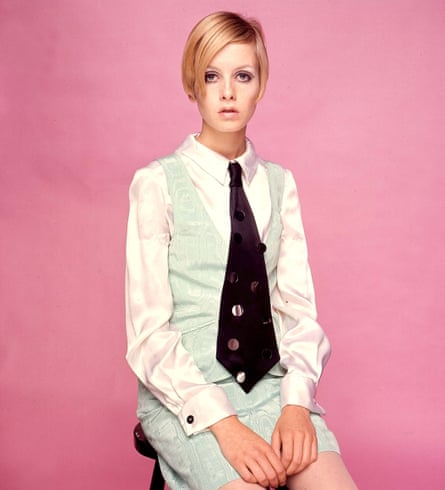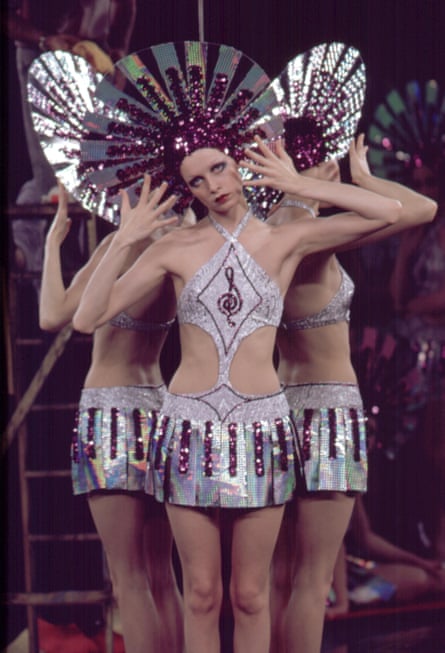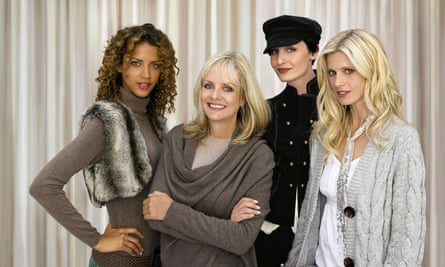So enduring is that image of Twiggy – side-swept hair, heavy eyes, delicate neck – that it’s strange to think she was a model for only four years.
But Twiggy is an expert at reinvention (or “branching out” as her joke goes). The schoolgirl known as Lesley Hornby became Twiggy, the face of the 1960s, recognised then and now by a single name. At 21, she became the all-singing, all-dancing star of Ken Russell’s 1971 film The Boy Friend, which won her two Golden Globes. She has performed on Broadway, recorded albums and been a TV presenter. In her 60s, she turned fashion designer, with several collections for Marks & Spencer. Last year, she was given a damehood.

What can be next? Podcasts, of course. At 70, she is about to launch Tea With Twiggy, in which she will interview famous friends including Joanna Lumley, Elaine Paige and Christopher Biggins “about their careers, their pasts, their childhoods, and things they’re doing at the moment”, she says. The lockdown has been an opportune moment to get started on it. “There are so many horrible stories on the news,” she says. “I wanted people who could tell lovely stories and be funny.”
I speak to Twiggy by phone; she’s in the flat she shares with her husband, the actor and director Leigh Lawson. She is missing her family the most during lockdown – her daughter had a baby in February, Twiggy’s fifth grandchild (her stepson has three). “I got to hold him the day he was born, then I got to visit about four days later,” she says. “And then by March …” We all know what happened next. She video calls her grandchildren, and sends them the recordings she and her husband make of them reading stories. “Apart from that, we’re lucky, we’ve got each other, Leigh and I,” she says.
She is a good talker and generous with her laughter – until a question displeases her. But you don’t, I suppose, survive for more than five decades in the public eye by being a pushover.
It’s remarkable she never lost the plot after all these years in the spotlight. “I was so straight it’s boring,” she says, and laughs. It was the late 60s when she was launched into international fame, but she insists she never took drugs. “The worst thing I did was smoke cigarettes.” She didn’t even drink wine until she was in her late 20s. “I didn’t like it. I grew up in Neasden, we drank tea.”
Twiggy was the youngest of three daughters. She remembers a happy childhood , although one where her mother, Nell, would occasionally be admitted, sometimes for months at a time, to a psychiatric hospital. “I think today [she would have been] diagnosed as bipolar,” says Twiggy. “I had the most amazing dad, Norman, who I loved and adored. He was from Lancashire, very sensible, very down to earth, very calm. So when Mum … I think anyone with bipolar, they’re not ill all the time, they can go months or even years being absolutely fine and then something happens that makes them plummet into depression. But my dad was there.” Her sister Shirley, who was 15 years older than her, would also step in, “so I was very protected really. It wasn’t until I grew up and looked back and thought it must have been really hard on Dad.”
Twiggy was close to her mother. “I wouldn’t go anywhere without my mum. It’s amazing what happened to me because I was so shy and insecure.” She says she “never even thought” of becoming a performer. But she loved fashion and had pictures of the model Jean Shrimpton on her bedroom walls “along with the Beatles”, so had vague ambitions to become a model or fashion designer.
Her sister, Vivien, was seven years older, “and I can still remember in detail clothes she made and really wanting to be like her”. Twiggy was a mod and was allowed out to a club in Harrow on Saturday nights as long as she was home by 10.30pm. “We’d look at all the other mods and see what they were wearing and then try to copy that. I used to make a lot of the stuff. That was the huge influence on me, fashion-wise. Then, by the mid-60s, just before I was discovered, people like Barbara Hulanicki gave us Biba.” The boutique for young women in Kensington “became my obsession. Because before that, you could either buy clothes from children’s shops or you could buy women’s clothes from department stores.”
Twiggy wasn’t allowed to wear makeup, but at the weekends she and her friends would practise doing their faces. She made her eyes look like the ones painted on her rag doll, just playing around, but it became her look. “It used to take me an hour and a half to do, I had three pairs of false eyelashes on the top. I’m amazed I could open my eyes.” She laughs. “Then I used to paint the lines underneath. So in 1966, when I was plucked from anonymity into the madness it became, that was my look.”
She was discovered when a newspaper fashion journalist came across some photographs of her modelling a new cropped hairstyle for a celebrity hairdressers’. “Within a month, I was all over the newspapers, I was getting offers to go to Paris. I can’t say I didn’t like it. I loved it, it was brilliant.” The following year she went to New York, and became even more famous. “Sonny and Cher gave me a party in Hollywood,” she recalls. She remembers being searched at the airport for drugs. “I think they figured that anyone from swinging London must be …” She doesn’t finish the sentence. “But you know, it’s probably why I survived, because I was so straight.”
The fashion world, like others, has been rocked by allegations of sexual assault in the wake of the #MeToo movement. Twiggy has said before that she never experienced any harassment, partly because she had a manager, Justin de Villeneuve (an art dealer and photographer who changed his name from Nigel), who travelled everywhere with her. ““My dad had worked in the film industry, so he obviously saw things that went on. And he said: ‘If you’re going to go to these studios and travel, you have to have somebody with you.’ So I was never ever hit upon.” A lot of the women who experienced the worst of it were trying to make their way into the industry and were more vulnerable, she points out – Twiggy had already very definitely made it.
De Villeneuve was also Twiggy’s boyfriend. They had met when she was 15 and he was 25. Does she look back and feel that was exploitative? “It’s not an area I cover so you can look it up in books if you want,” she says. “I don’t talk about that.” In her 1997 autobiography, she writes: “Looking back he should never have taken me out, I was far too young and he was far too old.”

She also writes that it has irritated her that over the years the story has been that “Justin was the Svengali and I was the dumb blond”. Instead of being the delicate, naive person her appearance back then would have you believe, she was steely. There is a clip of an interview with her from 1970. Responding to an inane question about a curvier shape being back in fashion, she replies, cool-eyed: “The bosom has never been out. That would mean that women have been out, which is ridiculous, isn’t it?” She also said she was “very bored” with modelling.
“I didn’t suddenly stop one day and think: ‘I’m not going to model any more,’” she says now. But by then she had met Ken Russell, the film director. She went along to lunch with him – it was an informal audition – and when she turned up, Paul McCartney was also sitting at the table. “Every teenage girl had a favourite Beatle and mine was Paul McCartney,” she says. “Three years before, I’d been one of the screaming girls at one of his concerts. I had to go and sit at this lunch, opposite the most famous film director in England and my idol and try and be normal and interesting.”
Russell, she says, “became like my mentor”. She would go to his house and watch old musicals with him and his wife, Shirley. He cast her as the star of The Boy Friend, an extravagant musical, for which Twiggy had singing and dancing lessons for a year. It’s an extraordinary first film to do. “I’d have been a bit of a fool to turn it down,” she says. She would win two Golden Globes for the part and later, one of her co-stars, Tommy Tune, would cast her in his 1983 Broadway production. “At least with a film, I was not frightened of cameras, I had worked in the modelling industry for four years. But to go out on a Broadway stage in front of 2,000 people every night and sing and dance, that’s scary.” It was, however, “the greatest professional thing I’ve ever done because it proved to me that I could do something that I thought I couldn’t.”
Did she have a plan for her career? “No. I don’t think you can. You can have a goal of what you want to do, but you can’t plan it because you’ve got to be offered parts.” Twiggy was certainly well-connected – there are great stories in her autobiography about meeting Fred Astaire, and running away from Phil Spector’s house. She worked with David Bowie and attended Hollywood parties with Elizabeth Taylor. Although she worked fairly steadily throughout the 80s and 90s, she never quite reached the heights of her early career. “I did a couple of films that were duds, everyone does. But I think I’ve had a brilliant career. And more importantly I’ve had a very happy life.”
The closest there has been to Twiggy, in terms of exposure and era-defining influence, has been Kate Moss (they are friends). Both have been blamed in their time for pushing an aesthetic of extreme thinness. It’s not fair to single out the model – it’s the industry in which they work that is at fault – but how does she feel about the conversations around body image now? Does the fashion industry still need to change and focus more on different shapes? “Well, it has, hasn’t it, there are so many more ads now,” she says. “It’s the same with older models, they’re using middle-aged and older women in commercials. I don’t think the high fashion industry will ever go completely away from slimness but I think other parts of the industry have started to use different shapes and sizes, and I think they should.” Her range for M&S, she points out, went from a size eight to a 22.

In 2009, an advert for an eye cream, featuring Twiggy, was banned by the Advertising Standards Authority for being misleading because it had been airbrushed. “That was nothing to do with me. I can’t stop people …” She trails off. “I go and do a job. If they take it away and do the stuff, it’s absolutely nothing to do with me.” There’s a growing number of younger women, I say – I’m thinking of the actor Jameela Jamil – who refuse on principle to be airbrushed, because of the unrealistic messages it sends women. “I have no idea, it’s up to them. I don’t have any control over that,” says Twiggy, sounding increasingly prickly. We go back and forth a bit. Does she mind that she is airbrushed? There is a pause. “I think we should get off this subject because you’re getting really boring,” she says.
So I ask her what she wants to do next, though the atmosphere doesn’t really recover. She was about to go into the studio to record a new album, which she wants to get back to at some point. She still loves fashion design and has been doing more knitting and sewing during these lockdown days, much like in her teenage years. “I wonder what she would say to her 16-year-old self now. “Oh, just go for it. And enjoy it. I think I did most of the time. I don’t look back and think ‘I wish I hadn’t done that’.”
